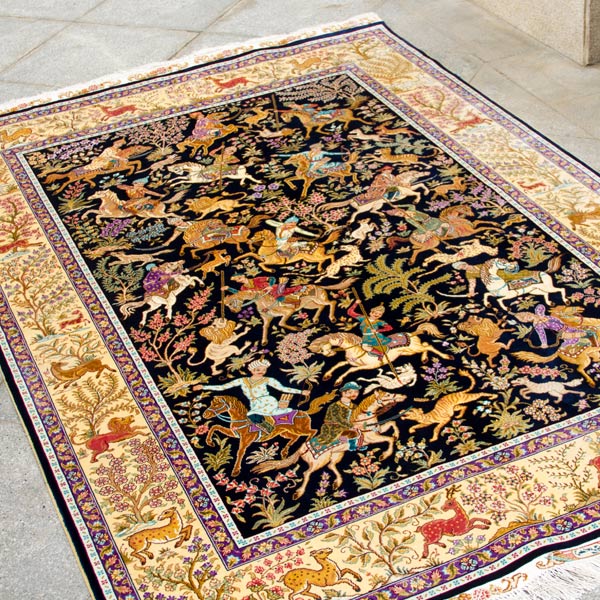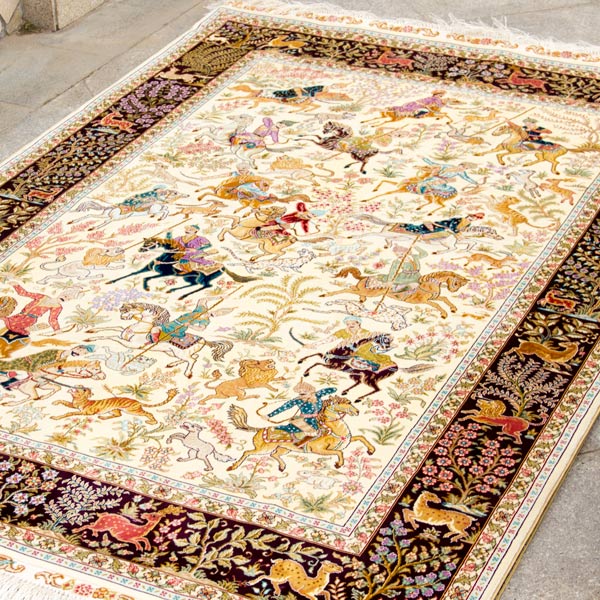
Learn about Persian hunting rug
The hunting scene rug design is an ancient weaving style. Originally created for Shahs and imperial leaders, the Persian hunting rug embodies a regal handsomeness and masculinity that is seldom seen in Persian carpets. Rugs bearing the classic Persian hunting design include the oldest existent pile carpet as well as the most valuable silk carpets known today.
For more than one thousand, three hundred years, Persian hunting stories were told orally. As hunting was such an imperative tradition to Persians, it became a heritage that they needed to protect and preserve. In 500 B.C, hunting scenes were put on one of the oldest rugs: the Pazyryk rug. This treasure was found in the Scythian prince’s tomb. It featured rows of deer in the inside border as well as rows of horsemen in the outside border. This beautiful rug is thought to be conserved in Altai Mountains. Pazyryk rug’s main motifs depict the Assyrian Empire (that ruled over Mesopotamia), the Persian Achaemenid Empire and the age-old Iranian Scythians who lived in Altai area and Asian plains.

Despite the early emergence of the Persian hunting rug, depictions of people, animals and huntsmen are not seen again until the 1500s and the height of Safavid rule. Scholars believe the disappearance of hunting designs coincided with the increasing influence of Islamic empires. Aside from tribal pieces decorated with geometric people and animals, these depictions were viewed as a form of idolatry.
By the 16th century, Safavid leaders in Persia and Mughal leaders in sub-continental India were commissioning ornate hunting carpets depicting an elite sport and beloved pastime. Thanks to a date and master weaver’s signature woven in one hunting carpet from Kashan that is displayed in Milan, scholars know that the hunting format, including mounted huntsmen and archers set against a lush forested background, emerged during the mid-16th century.
Animals depicted on hunting carpets include horses, camels, war elephants, gazelle, deer, birds, hares, peacocks and mythical creatures like griffins, which are most notably included in the Pazyryk rug. Isfahan, Khorassan, Kerman, Kashan, Qum and Tabriz have been creating outstanding pictorial carpets for centuries. These large weaving centers have traditionally been home to the master weavers and infrastructure needed to create these exceptionally detailed carpets.

Due to differences in construction and materials, the knot count for hunting carpets varies from 350 knots per square inch on a symmetrically knotted wool carpet from Tabriz to 700 knots per square inch on an asymmetrically knotted silk hunting carpet from Isfahan. Because Persian rugs featuring elaborate hunting scenes were first created for the empire’s elite leaders, there is a long tradition of using silk to achieve the extremely fine designs, minute outlines, detailed animal’s fur and unique expressions of the huntsmen. In Qum and Iran's great carpet-producing centers, weavers are known for using fine outlines to create fingernails, eyelids, facial wrinkles and extreme details that make their hunting rugs come to life.

Hunting scene rugs are perfect additions to any house no matter its main interior design theme. They tend to feature different colors, shapes, sizes and symmetrical or asymmetrical knotting patterns. Regardless of where you live on earth, these hunting scene rugs can be found and ordered online. Some of the legendary art pieces are also preserved in some of the highly recognized museums. You may or may not have seen Persian rugs with the hunting design. Now is your chance to research, get familiar with these rugs and then purchase the hottest product for your home decoration.
